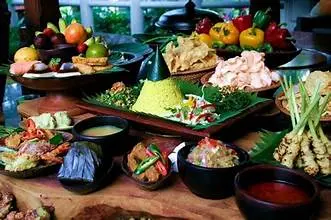Balinese cuisine is a vibrant tapestry of flavors, shaped by the island’s rich cultural heritage and the abundance of fresh, local ingredients. Unlike other Indonesian cuisines, Balinese food has its own distinctive character, influenced by indigenous traditions as well as Indian, Chinese, and Javanese culinary practices. This unique fusion creates a gastronomic experience that reflects Bali’s position as a cultural crossroads in the Indonesian archipelago.
The Philosophy of Balinese Cooking
At the heart of Balinese cooking is the concept of “Rwa Bhineda,” the philosophy of balance and harmony between opposing forces. This Hindu-Buddhist principle translates to a careful balance of flavors in each dish – spicy and sweet, sour and savory, crispy and tender. Every meal is considered a spiritual offering, with food preparation viewed as a meditative practice that connects the cook with the divine.
The Balinese believe that food should nourish not just the body but also the soul. This philosophy extends to the presentation of dishes, which often feature intricate garnishes and colorful arrangements that please the eye as much as the palate.
Essential Ingredients and Spice Blends
Balinese cuisine relies on a core set of ingredients that give it its distinctive flavor profile, many of which are grown in the island’s fertile volcanic soil.
Base Genep (Bumbu Base)
This traditional spice paste forms the foundation of many Balinese dishes and varies slightly from family to family. A typical base genep includes:
- Galangal (laos) - Similar to ginger but with a citrusy pine flavor that adds depth and warmth
- Turmeric (kunyit) - Giving dishes their distinctive golden yellow color and earthy flavor
- Fresh ginger (jahe) - Providing heat and aromatic intensity
- Garlic and shallots (bawang putih dan merah) - The aromatic foundation of most dishes
- Candlenuts (kemiri) - Used for thickening sauces and adding richness
- Chili peppers (cabe) - Ranging from mild to extremely hot varieties
- Coriander seeds (ketumbar) - Adding a lemony, slightly sweet flavor
- White pepper (merica putih) - Providing subtle heat without overpowering other flavors
Other Key Ingredients
- Kencur (aromatic ginger) - A smaller, more pungent relative of ginger
- Lemongrass (serai) - Adds citrusy fragrance to curries and soups
- Kaffir lime leaves (daun jeruk) - Provides intense citrus aroma
- Tamarind (asam jawa) - Creates the signature sour notes in many dishes
- Palm sugar (gula merah) - Balances spicy and sour flavors with natural sweetness
- Coconut in various forms - Fresh, milk, oil, and grated for texture and richness
The Art of Balinese Cooking Techniques
Balinese cooking employs several traditional techniques that have been passed down through generations:
Roasting and Grinding Spices
Spices are traditionally dry-roasted in clay pans to intensify their flavors before being ground using a stone mortar and pestle (cobek). This labor-intensive process creates more complex flavor profiles than using pre-ground spices.
Slow Cooking Methods
Many traditional Balinese dishes require hours of slow cooking, allowing flavors to develop and intensify. Clay pots (periuk tanah) are preferred for their ability to distribute heat evenly and impart subtle earthy flavors.
Banana Leaf Wrapping
The technique of wrapping ingredients in banana leaves (daun pisang) before cooking serves multiple purposes: it steams the food naturally, infuses subtle vegetal flavors, and creates an aromatic presentation.
Iconic Balinese Main Dishes
Babi Guling (Suckling Pig)
Considered Bali’s signature dish, babi guling is a festive specialty that showcases the island’s Hindu culture, where pork consumption is not restricted. The preparation begins with a whole suckling pig stuffed with a complex spice paste containing turmeric, coriander seeds, lemongrass, black pepper, garlic, and chilies. The pig is then skewered on a bamboo pole and roasted over an open fire for several hours, constantly turned to ensure even cooking.
The result is meat that falls off the bone, crispy crackling skin, and rice infused with aromatic drippings. Babi guling is traditionally served during religious ceremonies, weddings, and important celebrations, accompanied by lawar (spiced vegetable salad) and steamed rice.
Bebek Betutu (Slow-Cooked Duck)
This ceremonial dish is considered the crown jewel of Balinese cuisine. The preparation begins by cleaning a whole duck and rubbing it inside and out with a specially prepared base genep spice paste. The seasoned duck is then wrapped tightly in banana leaves and slow-cooked for 6-8 hours using traditional methods.
In villages, bebek betutu is often cooked underground in pits filled with burning rice husks, creating an oven-like environment that cooks the duck evenly while infusing it with smoky flavors. The long cooking process breaks down tough fibers, resulting in meat so tender it can be eaten with a spoon. The spices penetrate deep into the meat, creating layers of complex flavors.
Ayam Pelalah (Shredded Spiced Chicken)
This dish features shredded chicken mixed with a fiery sambal made from bird’s eye chilies, shallots, garlic, and lime juice. The chicken is first boiled with aromatic herbs, then shredded by hand and mixed with the raw sambal. The dish is served at room temperature and is prized for its intense heat and fresh flavors.
Sate Lilit (Balinese Fish Satay)
Unlike traditional Indonesian satay, sate lilit uses minced fish (usually mackerel or tuna) mixed with grated coconut, base genep spices, and palm sugar. The mixture is wrapped around lemongrass stalks or bamboo sticks and grilled over coconut husk charcoal. The result is a smoky, aromatic satay with a unique texture and intense flavor.
Traditional Balinese Vegetable Dishes
Gado-Gado Bali
The Balinese version of this Indonesian salad features blanched vegetables including bean sprouts, long beans, cabbage, and tofu, topped with a rich peanut sauce that’s spicier and more complex than its Javanese counterpart. The sauce includes roasted peanuts, chilies, palm sugar, tamarind, and kencur.
Lawar
This traditional mixed salad combines finely chopped vegetables, grated coconut, and minced meat (pork, chicken, or duck) with a spicy dressing made from chilies, garlic, ginger, and sometimes fresh blood for added richness and color. There are dozens of lawar variations, each associated with specific ceremonies or regions.
Urap
A simple but flavorful dish of blanched vegetables mixed with seasoned grated coconut. The coconut is typically seasoned with chilies, shallots, garlic, and lime juice, creating a fresh and healthy side dish that complements richer main courses.
Balinese Soups and Curry Dishes
Soto Ayam Bali
This aromatic chicken soup features a clear, flavorful broth infused with lemongrass, galangal, and turmeric. Served with shredded chicken, bean sprouts, boiled eggs, and crispy shallots, it’s often enjoyed as a breakfast dish or light meal.
Gulai Kambing (Goat Curry)
A rich, coconut-based curry featuring tender goat meat cooked with a complex spice paste. The dish reflects Indian influences on Balinese cuisine and is often served during special occasions and religious festivals.
Jukut Ares (Young Jackfruit Curry)
This vegetarian curry showcases the Balinese talent for creating flavorful dishes from simple ingredients. Young jackfruit is cooked in coconut milk with base genep spices, creating a hearty, satisfying dish often served during Hindu religious ceremonies.
Rice: The Sacred Staple
Rice holds sacred significance in Balinese culture and cuisine. The island grows several varieties, each with specific culinary applications:
Nasi Putih (Steamed White Rice)
The foundation of every Balinese meal, perfectly steamed rice is considered a gift from the rice goddess Dewi Sri. The rice is often shaped into decorative cones for ceremonial presentations.
Nasi Kuning (Turmeric Rice)
Yellow rice cooked with coconut milk and turmeric, served during celebrations and religious ceremonies. The golden color symbolizes prosperity and divine blessing.
Nasi Jinggo
A popular street food consisting of small portions of rice served with various toppings including shredded chicken, tempeh, sambal, and vegetables, all wrapped in banana leaves.
Street Food and Snacks
Pisang Rai
Steamed bananas wrapped in rice flour dough and covered with freshly grated coconut, creating a sweet and satisfying snack that’s popular throughout the day.
Klepon
These green rice balls are filled with liquid palm sugar and rolled in grated coconut. When bitten, they “explode” with sweet syrup, creating a delightful textural contrast.
Jaje Bali (Traditional Balinese Cakes)
A variety of colorful rice-based cakes and sweets, often naturally colored with pandan leaves, butterfly pea flowers, and other natural ingredients. These are essential components of religious offerings and celebrations.
Beverages and Refreshments
Es Campur Bali
A refreshing shaved ice dessert topped with various ingredients including avocado, jackfruit, coconut strips, and colored syrups. Perfect for cooling down in Bali’s tropical climate.
Arak
Traditional Balinese rice wine that ranges from clear and potent to sweet and aromatic. Often used in cooking and religious ceremonies, arak is also enjoyed as a social drink.
Tuak
Palm wine made from the sap of palm trees, enjoyed fresh or allowed to ferment for a stronger alcoholic content. It’s often flavored with herbs and spices.
Regional Variations Across Bali
North Bali (Buleleng)
Known for milder flavors and greater use of seafood, reflecting the region’s coastal location. Dishes often feature less chili and more emphasis on fresh herbs.
East Bali (Karangasem)
Famous for its salt production, this region’s cuisine features more preserved and dried ingredients. The proximity to Mount Agung influences local agriculture and ingredient availability.
West Bali
Shows stronger Javanese influence due to its proximity to Java, with dishes that are often sweeter and less spicy than those from other regions.
Central Bali (Ubud Region)
Known for its organic farming and health-conscious approach to traditional recipes, with many restaurants offering vegetarian and vegan interpretations of classic dishes.
The Cultural Significance of Food in Balinese Society
Food in Balinese culture extends far beyond mere sustenance. Every meal is considered a form of communion with the divine, and specific dishes are associated with religious ceremonies and life events. The preparation of food is often a communal activity, bringing families and communities together.
Ceremonial Dining
During temple festivals (odalan) and religious ceremonies, elaborate feasts called “megibung” are prepared, where entire communities contribute dishes and eat together sitting cross-legged on mats. These communal meals strengthen social bonds and cultural identity.
Food Offerings (Canang Sari)
Daily food offerings to gods and spirits are an integral part of Balinese Hindu practice. These offerings, made from rice, flowers, and small portions of prepared dishes, demonstrate gratitude and maintain harmony between the physical and spiritual worlds.
Modern Influences and Evolution
Contemporary Balinese cuisine continues to evolve while maintaining its traditional foundations. Modern chefs are experimenting with traditional recipes, creating fusion dishes that appeal to international palates while respecting authentic flavors and techniques.
Health-conscious interpretations of traditional dishes are becoming popular, with restaurants offering organic, locally-sourced ingredients and plant-based versions of meat dishes. However, the core principles of balance, fresh ingredients, and complex spice blends remain unchanged.
Tips for Experiencing Authentic Balinese Cuisine
Where to Find Authentic Food
- Local warungs (small family-run restaurants) offer the most authentic experiences
- Traditional markets provide insight into ingredients and cooking methods
- Temple ceremonies offer opportunities to experience communal dining
- Cooking classes provide hands-on learning experiences
Etiquette and Customs
- Always eat with your right hand
- Wait for the eldest person to begin eating
- Try a little of everything offered
- Compliment the cook, as food preparation is considered an art form
- Be prepared for varying levels of spiciness
Balinese cuisine represents more than just food – it embodies the island’s spiritual beliefs, cultural values, and connection to the natural world. Each dish tells a story of tradition, innovation, and the enduring human desire to create beauty and meaning through the simple act of cooking and sharing meals. Whether you’re savoring the complex flavors of bebek betutu or enjoying the fresh simplicity of lawar, Balinese cuisine offers a profound cultural experience that nourishes both body and soul.



